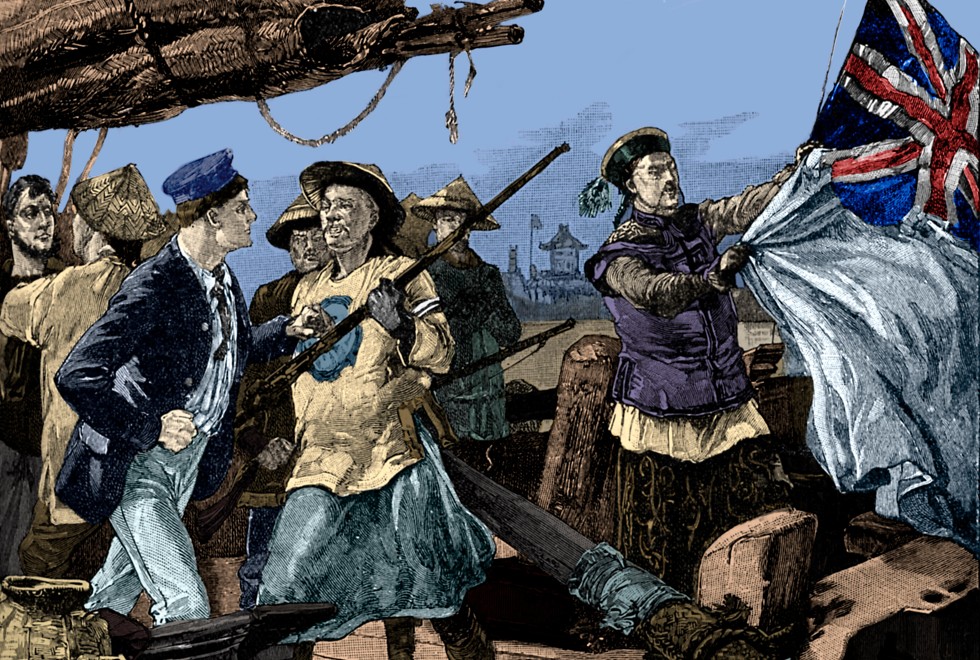
Why China’s record in honouring historical agreements smacks of cherry-picking
How could China dismiss the 1984 Joint Declaration as meaningless, yet days later cite an 1890 treaty signed with Britain in support of a territorial claim in the Himalayas? It’s all about convenience
“History is the best textbook” is a mantra of the Xi Jinping era, often on the Chinese president’s lips and frequently repeated by state media. So it was surprising when Foreign Ministry spokesman Lu Kang recently suggested that history might be ignored, or had an expiry date.

China’s first international treaty with a foreign power was 1689’s Treaty of Nerchinsk. This set out the Qing empire’s border with an expanding Russian empire, allowed for a Russian settlement in Beijing with the aim of training interpreters, and agreed on certain formal trading relations that handed Russia a near-monopoly in the transport of Chinese rhubarb root, then highly valued in Europe as a panacea.

The treaty was negotiated for the alien Manchu rulers of China by equally alien Jesuits, Frenchman Jean-François Gerbillon and Portuguese Tomás Pereira, interpreters and legal advisers to the Qing Kangxi emperor. The authoritative text was in an alien language, Latin, the lingua franca of the negotiators. There was little about the agreement that was Chinese.
Pragmatic Manchu officials were willing to learn the form of international treaties and accept language that allowed the other party to appear as an equal rather than as supplicant, a first for Chinese trade relations. Pacifying the Russians with trade privileges and territory allowed the Qing to concentrate on reducing a more potent military threat in the neighbourhood, the Dzungars of western Mongolia.
By the 19th century, the traditional narrative that all outsiders were mere moths drawn to China’s brighter cultural flame had also become Manchu orthodoxy
The Chinese and their Manchu rulers proved to be less interested in keeping to the terms of their agreements with Great Britain, which seemed to have no “realistic meaning” from the moment they were signed.
The first of these was the Treaty of Peace, Friendship, Commerce, Indemnity, &c., between Great Britain and China, signed in Nanking (Nanjing) in 1842. China had just learned painfully that Great Britain, not itself, was the global superpower of the day, capable of projecting force a third of the way around the world and defeating a far larger adversary.
China’s Qing-enforced seclusion had left it militarily backward and ignorant of foreign technological developments, so the preceding war of 1840-42 had been marked by a string of easy victories for the invaders. The Qing again purchased peace with promises of trade and territory.
By the 19th century, the traditional narrative that all outsiders were mere moths drawn to China’s brighter cultural flame had also become Manchu orthodoxy. As a result, such limited trade arrangements as the Qing were prepared to make were all regarded as unequal in the sense that communications expressed Chinese superiority and condescension, and all seaborne foreign trade was restricted to the single port of Canton (Guangzhou).
The Treaty of Nanking was also unequal except in its language, but the balance had tipped the other way, with the Qing the weaker party forced to open Canton and four further ports to full-time foreign residence, and to cede Hong Kong Island to British rule in perpetuity.
To ease trade, duties were fixed for the transit of foreign goods from the ports to the interior. The Qing repeatedly breached the agreement, particularly in the matter of transit duties, and did not enforce the permission granted for foreigners to reside year-round in restless Canton. This breach was addressed in a Sino-British Convention of 1846, and yet again in an Agreement of 1847.
Finally, an incident in 1856, in which Chinese authorities boarded a ship of nominally British registration, led to the second opium war, in which further British military activity forced on the Qing the Treaty of Peace, Friendship, and Commerce, between Great Britain and China, signed in Tientsin (Tianjin) in 1858. This opened up further areas for trade and compelled the Qing to accept the residence of foreign diplomats in Peking (Beijing). It also dealt with continuing breaches of previous agreements to limit transit duties.
The British were still in pursuit of full Chinese acceptance of their equality, and the 1858 treaty included a clause forbidding the use of yí (夷) – “barbarians”, at least in some interpretations – to refer to the British.
Experience had by now taught them not to expect the Qing necessarily to adhere to the terms of any agreements they signed, and the British secretary of state for war, Sidney Herbert, prophetically described the 1858 document as “a treaty of peace with a casus belli in every clause”.
In a bluntly worded letter of March 1859 to envoy Frederick Bruce, British foreign minister the Earl of Malmesbury made it clear that he anticipated difficulties, especially with the agreement to exchange ratifications of the treaty at Peking.
“Her Majesty’s Government are prepared to expect that all the arts at which the Chinese are such adepts, will be put in practice to dissuade you from repairing to the capital, even for the purpose of exchanging the ratifications of the Treaty,” he wrote.
But Bruce was instructed to stand firm.
“You will say that the effect of any persistence on the part of the Chinese Government in throwing obstacles in the way of your arrival at Pekin, and of your presentation of your credentials to the Emperor in person, will be that Her Majesty’s Government will insist on the literal fulfilment of the Treaty, and establish the Mission at Pekin.”
British and French forces had finally opened Canton to the foreign residence agreed by treaty, although this required fighting their way into the city in 1857. Similar force proved necessary at Peking.
The Chinese repelled the fleet conveying Bruce and his party at the Taku (Dagu) forts, outside Tientsin. This led to the dispatch of an invasion force, which despite its small size, successfully entered Peking in 1860. A modified form of the 1858 treaty, the Convention of Peace and Friendship between Great Britain and China, was signed in Peking in October that year.
A Chinese magistrate ordered the beating and beheading of French missionary Auguste Chapdelaine in 1856 on the grounds that he had been preaching Christianity in the interior in breach of Chinese law. When authorities declined to provide what the French regarded as adequate compensation, the French tacked lesser forces onto those of the British expedition to Peking, to seek territorial and trade privileges.
The British would use similar tactics in drawing up the Agreement between Great Britain and China for the Settlement of the Yunnan Case, Official Intercourse and Trade between the two Countries, signed at Chefoo (Yantai), in 1876.

The British minister in Peking, Sir Thomas Wade, not only demanded financial compensation but also the opening of four further ports, and he used the negotiations as a broom with which to sweep up a number of entirely unrelated issues, including continuing interference by Chinese customs cruisers in Hong Kong’s junk trade, the application of different kinds of justice to foreign and Chinese miscreants at open ports, and once again the problem of fixed-rate transit duties for imported goods, covered in several previous agreements.
But when some years later, Tengyue (Tengchong, in Yunnan province – the Burma trade delegation’s planned destination) was also opened to foreign residence as a treaty port, one British consul discovered that, despite the supposed abolition of transit taxes, there were still 21 tax barriers on a single route from the border, making imports entirely impractical.
Wade would likely not have been surprised, as he did not expect the Chinese to adhere to the terms of the treaty. He made provisions in it not only for an imperial proclamation to be posted across China notifying the populace of foreigners’ freedom to travel, but that for two years, British officials would conduct inspections to make sure the proclamation had been posted in accordance with the agreement.
Perhaps by the time of the Joint Declaration of 1984 over Hong Kong, this lesson had either been forgotten by British authorities or past experience was wilfully overlooked. Or perhaps the British considered themselves to be signing an agreement with an entirely different sort of government, as well as a treaty that was in this case “unequal” in the sense that the Chinese side had the upper hand.
The 1890 Sikkim convention was equally attractive to both sides. Britain gained recognition of its control of Sikkim and the Qing, despite having no control over Tibet at the time, gained implicit recognition of their authority there – an argument still trotted out in support of continued Chinese rule.
Unmentioned in these discussions are the 1904 Treaty of Lhasa (signed between the British Empire and Tibet) and the Convention between Great Britain and China respecting Tibet, signed in Peking in 1906. The Tibetans had declined to recognise the 1890 agreement, which led to various incursions the Chinese had no power to prevent, and which in their turn led to a British invasion of Tibet. The resulting Anglo-Tibetan agreement on the border tacitly recognised the Tibetans’ control over their own affairs, and with the Sino-British agreement of 1906, the Chinese acknowledged the independent decision of the Tibetans.

“Former Indian Prime Minister Jawaharlal Nehru endorsed the 1890 Sino-British Treaty on Sikkim in letters to then Chinese counterpart Zhou Enlai in 1959,” he was quoted in The Times of India newspaper as saying, in July.
Nehru did indeed write, “This Convention of 1890 also defined the boundary between Sikkim and Tibet; and the boundary was later, in 1895, demarcated. There is thus no dispute regarding the boundary of Sikkim with the Tibet region.” But the Hindustan Times newspaper was quick to point out that the Chinese account of the correspondence had been carefully edited.
Nehru went on to say, “This clearly refers to northern Sikkim and not to the tri-junction which needed to be discussed with Bhutan and Sikkim and which is today the contentious area.”
So, even if the 1890 “historical document” is, uniquely among the “unequal” treaties, to be honoured rather than breached or repudiated altogether, it does not address China’s claims to the “contentious” 89 sq km Doklam territory shown on modern maps as Bhutanese.
Keeping to the terms of international agreements continues to be a problem. In addition to difficulties with the Joint Declaration, China has been found in breach of the United Nations Convention on the Law of the Sea for its activities in the South China Sea and claims to excessive maritime territory.
China is also the respondent in 21 cases at the World Trade Organisation, which include claims of treaty-breaching restrictions on imports that would have sounded familiar to British negotiators in the 19th century.
Former China resident Peter Neville-Hadley is the author of guides and reference works on China, and writes on Chinese culture and on cultural travel in general.



